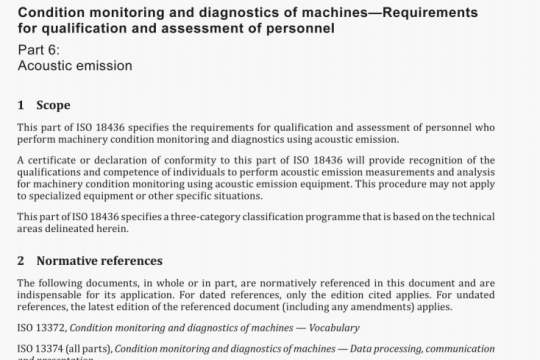BS ISO 14558:2016 pdf free
BS ISO 14558:2016 pdf free.Rubber – Determination of residual unsaturation of hydrogenated nitrile butadiene rubber (HNBR) by infrared spectroscopy
The following documents, in whole or in part, are normatively referenced in this document and are indispensable for its application. For dated references, only the edition cited applies. For undated references, the latest edition of the referenced document (including any amendments) applies.
ISO 1795, Rubber, raw natural and raw synthetic一Sampling and further preparative procedures
Raw, unvulcanized HNBR is purified by precipitation with methanol from a solution in methyl ethyl ketone (MEK) or by extraction of the solid HNBR with methanol in a Soxhlet apparatus.
The purified sample is dissolved in MEK and a film is cast on a potassium bromide (KBr) disc.
The IR spectrum of the film is obtained with a Fourier-transform (FT) or dispersive IR spectrometer.
The “corrected absorbance” of the specific absorbance bands for acrylonitrile (AN), butadiene (BD) and hydrogenated butadiene (HBD) are determined using the baseline method and the percentage of residual unsaturation (double bonds in unhydrogenated butadiene) is calculated with the aid of absorbance factors from the literature (see 8.5).
Transfer 1 g of the finely divided HNBR rubber sample into a 50 cm3 conical flask. Add 20 cm3 of MEK to the flask. Tightly stopper the flask and place it on a flask shaker and shake until the sample has completely dissolved.
Precipitate the rubber by slowly pouring the MEK solution into a 250 cm3 beaker containing 150 cm3 of methanol, while rapidly stirring the methanol with a magnetic stirrer.
Decant the solvent and wash the precipitated rubber with 50 cm3 of methanol. Decant the methanol washings and redissolve the precipitated rubber in 20 cm3 of MEK.
The precision parameters shall not be used for acceptance/rejection of materials without documentation that they are applicable to those materials and the testing protocols that include these test methods.
Interlaboratory precision was evaluated (see Table B.1). Both repeatability and reproducibility were short-term. A period of one week separated replicate test results.
Three different materials (grades of hydrogenated nitrile rubber) with different degrees of unsaturation were used in the interlaboratory programme. These were tested in seven laboratories on two different days one week apart. Duplicate tests were run on each day.BS ISO 14558 pdf free download.




